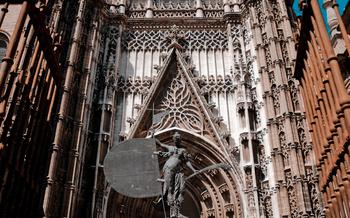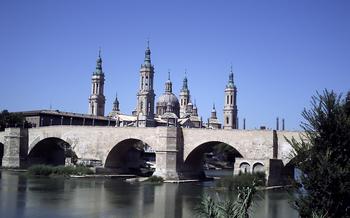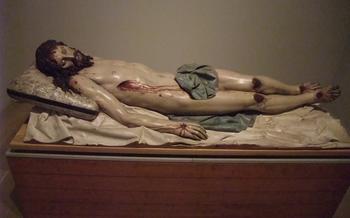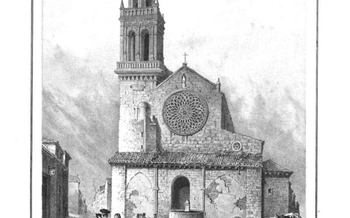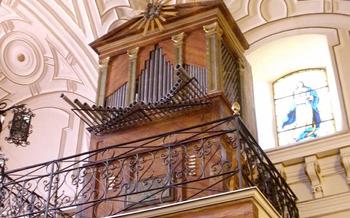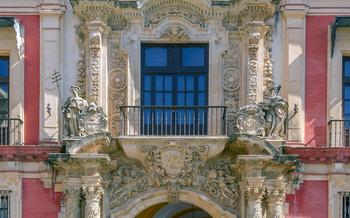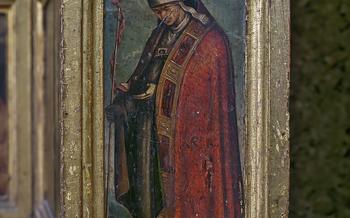
Iglesia de San Lorenzo
- Iglesia de San Lorenzo: A Monumental Treasure in Burgos
- Discover the Sculptures of Gil de Siloé
- Explore the Chapel of the Condestable
- Marvel at the Gothic Altarpiece
- Admire the Stained Glass Windows
- Take a Guided Tour for Deeper Insights
- Attend a Mass or Religious Service
- Explore the Surrounding Neighborhood
- Admire the Views from the Tower
- Attend a Concert or Cultural Event
- Learn about the Restoration Process
- Explore the Cloister and Gardens
- Plan Your Visit: Accessibility and Practical Tips
- Insider Tip: Hidden Gems and Local Insights
Iglesia de San Lorenzo: A Monumental Treasure in Burgos
The Iglesia de has graced the city's skyline for centuries. This magnificent church, which boasts the prestigious title of a UNESCO World Heritage Site, epitomizes the splendor of Gothic architecture, characterized by its intricate stone carvings, towering spires, and soaring buttresses. A significant landmark in its own right, the Iglesia de San Lorenzo is an integral part of the city's rich cultural and religious heritage, attracting pilgrims, art enthusiasts, and history buffs alike.
Conveniently located within the historic center of Burgos, the church is easily accessible by foot or public transportation, allowing visitors to seamlessly integrate their visit with other attractions and experiences the city offers. While approaching the church, the sheer grandeur of its facade, adorned with intricate carvings and sculptures, hints at the awe-inspiring beauty that awaits within.
Discover the Sculptures of Gil de Siloé
Gil de Siloé, a renowned sculptor from the 16th century, left an indelible mark on the Iglesia de San Lorenzo with his exquisite creations. Among his most notable works is the Cristo de la Agonía, a poignant depiction of Christ's suffering and agony on the cross. This masterpiece is renowned for its expressive details and emotional intensity, capturing the viewer's attention with its realism and depth. Siloé's other sculptures in the church, such as the Pietà and the Virgen del Pilar, showcase his mastery of form, proportion, and emotional expression.
Through his sculptures, Siloé sought to convey not only religious themes but also human emotions and experiences. He employed various artistic techniques to achieve this, including the use of polychrome and intricate carving to create lifelike figures. His works are imbued with symbolism, reflecting both Christian iconography and the artist's personal interpretations.
The historical context of Siloé's sculptures is significant, as they were created during a period of religious fervor and artistic renewal in Spain. His work was influenced by the Late Gothic style and the emerging Renaissance influences, resulting in a unique blend of artistic traditions. Siloé's sculptures served as a source of inspiration for subsequent generations of artists and continue to be admired for their technical brilliance and emotional depth.
Explore the Chapel of the Condestable
At the heart of the Iglesia de San Lorenzo lies the magnificent Chapel of the Condestable, a testament to the artistry and devotion of the Condestable family. Built in the 15th century, this chapel is a masterpiece of Gothic architecture, adorned with intricate carvings, stunning stained glass windows, and a breathtaking altarpiece.
The Condestable family, renowned for their power and influence in Burgos, commissioned the construction of this chapel as their final resting place. The chapel's design reflects their desire to create a sacred space that would honor their legacy and showcase their wealth and piety.
One of the most striking features of the chapel is its elaborate altarpiece, which depicts scenes from the life of Christ and the Virgin Mary. The altarpiece is a masterpiece of Gothic art, with intricate carvings and vibrant colors that bring the biblical stories to life.
Another highlight of the chapel is the Condestable's tomb, which is located in the center of the room. The tomb is adorned with sculptures of the Condestable and his wife, as well as their coats of arms. The Condestable's tomb is a reminder of the family's power and influence, and it serves as a fitting tribute to their devotion to God.
The Chapel of the Condestable is a must-see for anyone visiting the Iglesia de San Lorenzo. This stunning chapel is a testament to the artistry and devotion of the Condestable family, and it offers a glimpse into the rich history of Burgos.
Marvel at the Gothic Altarpiece
The Iglesia de San Lorenzo is home to a magnificent Gothic altarpiece, considered one of the finest examples of its kind in Spain. Created in the 15th century, this intricate masterpiece is a testament to the artistic prowess of its creators.
The altarpiece is divided into three sections, each adorned with intricate carvings and sculptures depicting scenes from the life of Christ and the Virgin Mary. The central section features a larger-than-life representation of the Crucifixion, flanked by panels depicting the Annunciation, the Nativity, and the Resurrection.
The side sections are equally impressive, with scenes from the lives of various saints, including Saint Lawrence, the church's namesake. The attention to detail and the expressive faces of the figures are simply breathtaking, showcasing the skill and artistry of the craftsmen who created this masterpiece.
The altarpiece is not only a visual feast but also a profound expression of faith and devotion. It serves as a reminder of the sacrifices and triumphs of Christ, offering visitors a glimpse into the rich spiritual heritage of the Catholic Church.
Over the centuries, the altarpiece has undergone several restoration efforts to preserve its beauty and integrity. These efforts have ensured that this masterpiece can continue to inspire and awe generations to come.
Admire the Stained Glass Windows
The Iglesia de San Lorenzo is renowned for its exquisite stained glass windows, which bathe the interior in a kaleidoscope of vibrant colors. These magnificent windows, crafted by skilled artisans over the centuries, depict biblical narratives and symbolic representations, offering a glimpse into the spiritual and artistic heritage of the church.
The windows, which vary in size and complexity, feature intricate designs and meticulous attention to detail. They showcase scenes from the life of Jesus Christ, as well as stories from the Old Testament and the lives of various saints. The vibrant hues of blue, red, green, and gold create a mesmerizing effect, transforming the church into a sanctuary of light and color.
The stained glass windows of the Iglesia de San Lorenzo not only serve as decorative elements but also hold profound symbolic meanings. They convey theological messages, illustrate biblical teachings, and inspire devotion among the faithful. The windows have also played a crucial role in preserving and transmitting religious iconography and narratives throughout history.
Over the centuries, the stained glass windows have undergone restoration efforts to ensure their preservation. These delicate works of art require specialized care and conservation techniques to maintain their brilliance and integrity. The ongoing efforts to restore and protect the stained glass windows guarantee that future generations can continue to marvel at their beauty and spiritual significance.
Take a Guided Tour for Deeper Insights
To fully appreciate the rich history and symbolism of the Iglesia de San Lorenzo, consider booking a guided tour. Led by knowledgeable guides, these tours offer in-depth explanations and insights into the church's architecture, sculptures, and artwork. You'll learn about the significance of key features, the stories behind the sculptures, and the historical context that shaped the church's design.
Recommended tour operators include the Burgos Tourism Office, which offers guided visits in multiple languages. Alternatively, private tours can be arranged with local guides who can tailor the experience to your specific interests. Whether you're an art enthusiast, a history buff, or simply curious about the church's significance, a guided tour will undoubtedly enhance your visit.
Insider tip: To make the most of your tour, come prepared with questions and don't hesitate to ask for further explanations or clarifications. Engaging with the guide and actively participating in the discussion will deepen your understanding and appreciation of the church.
Attend a Mass or Religious Service
Immerse yourself in the spiritual atmosphere of the Iglesia de San Lorenzo by attending a mass or religious service. Participate in the Catholic traditions and rituals that have been observed within these sacred walls for centuries. Dress respectfully and adhere to the prescribed etiquette to ensure a meaningful and enriching experience. Listen to the melodious choir performances and witness special events that bring the community together in faith and devotion. Experience the profound connection that this historic church fosters between its congregation and the divine.
Explore the Surrounding Neighborhood
Beyond the sacred walls of the Iglesia de San Lorenzo, the surrounding neighborhood beckons with its own unique allure. Step out and wander through the charming streets, where history whispers from every corner. Admire the architectural wonders of nearby landmarks, each with its own story to tell.
For a culinary adventure, seek out the local restaurants and cafes that line the streets. Savor the flavors of traditional Spanish cuisine, from hearty stews to delectable tapas. Indulge in the local specialties, such as the famous Burgos morcilla, a succulent blood sausage that will tantalize your taste buds.
If you're a shopaholic, you'll be delighted by the array of unique shops and boutiques that dot the neighborhood. From artisanal crafts to designer fashions, you're sure to find something to suit your taste. Take your time browsing the shelves and discovering hidden treasures that will remind you of your time in Burgos.
For a deeper immersion into the neighborhood's history and culture, consider joining a walking tour or embarking on a self-guided exploration. Follow in the footsteps of pilgrims and kings as you uncover the hidden stories that lie just beneath the surface of this vibrant district.
Admire the Views from the Tower
The Iglesia de San Lorenzo's tower, a prominent landmark of the Burgos cityscape, offers visitors a breathtaking panorama of the city and its picturesque surroundings. Ascend the tower's spiral staircase, accessible during specific hours, to reach the viewing platform. From this vantage point, you'll be rewarded with sweeping vistas that stretch across Burgos' historic center, the meandering Arlanzón River, and the distant peaks of the Sierra de la Demanda.
In the past, the tower served as a watchtower, allowing sentries to keep a vigilant eye over the city and surrounding lands. Today, it offers a unique perspective, allowing visitors to immerse themselves in the city's rich history while marveling at its architectural beauty from above. Capture panoramic photographs that will serve as lasting mementos of your visit to this magnificent church.
Attend a Concert or Cultural Event
The Iglesia de San Lorenzo is not just a place of worship but also a vibrant cultural venue that hosts a variety of concerts, recitals, and other cultural events throughout the year. The church's acoustics and stunning ambiance make it an ideal setting for musical performances, creating an immersive and unforgettable experience for attendees.
Past notable musicians and groups that have graced the stage of the Iglesia de San Lorenzo include renowned classical ensembles, celebrated organists, and talented choirs. The church's concert calendar features a diverse range of musical genres, from classical and sacred music to contemporary and experimental compositions.
To ensure a memorable experience, it is advisable to book tickets in advance, especially for popular events. Attendees can choose from various seating options, including pews, chairs, or even the choir loft, offering unique perspectives of the church's interior.
Whether you are a classical music aficionado, a fan of contemporary sounds, or simply seeking a unique cultural experience, attending a concert or cultural event at the Iglesia de San Lorenzo is a must. Immerse yourself in the beauty of music and art while surrounded by the splendor of this historic church.
Learn about the Restoration Process
Over the centuries, the Iglesia de San Lorenzo has undergone extensive restoration efforts to preserve its architectural integrity and artistic treasures. The church has faced various challenges, including natural wear and tear, damage from fires and wars, and the effects of time.
The restoration process involved meticulous cleaning and repair of the exterior and interior elements, including the intricate carvings, sculptures, and stained glass windows. Artisans and experts employed traditional techniques and materials to ensure the authenticity and longevity of the restoration.
One of the key challenges was addressing the structural issues caused by the movement of the ground over time. The foundations of the church were reinforced using modern engineering solutions, while maintaining the historical integrity of the building.
The restoration efforts have been ongoing for several decades, with the most recent phase completed in 201The successful restoration has allowed future generations to appreciate the beauty and significance of the Iglesia de San Lorenzo in all its glory.
Visitors can learn about the fascinating history of the restoration process through guided tours, informative panels, and interactive exhibits at the church. These insights provide a deeper understanding of the dedication and expertise that have gone into preserving this architectural masterpiece.
Explore the Cloister and Gardens
In the heart of the Iglesia de San Lorenzo, tucked away from the bustling nave, lies a tranquil oasis—the cloister and its adjoining gardens. Step into this serene sanctuary and be transported back in time as you admire the architectural wonders of the cloister. Its intricate stone carvings, delicate arches, and graceful columns create a picturesque backdrop that whispers tales of centuries past.
The cloister served as a place of contemplation and refuge for the monks who once resided here. As you wander through its peaceful corridors, imagine the hushed footsteps of these holy men as they sought solace and inspiration within these hallowed grounds. The well-maintained gardens, bursting with vibrant blooms and manicured greenery, offer a refreshing contrast to the grandeur of the church.
Take a moment to sit on one of the stone benches, surrounded by the gentle rustling of leaves and the sweet fragrance of flowers. Close your eyes and let the tranquil atmosphere wash over you, allowing your mind to wander and connect with the spiritual essence of this sacred space.
Whether you seek a moment of quiet reflection or simply want to escape the hustle and bustle of the city, the cloister and gardens of the Iglesia de San Lorenzo offer a welcome respite. Explore this hidden gem and discover the serenity that lies within.
Plan Your Visit: Accessibility and Practical Tips
For an inclusive and enjoyable experience, the Iglesia de San Lorenzo is equipped with accessibility features to accommodate visitors with disabilities. These features may include wheelchair ramps, elevators, or adapted restrooms, ensuring that everyone can fully appreciate the church's splendor.
To make the most of your visit, it is recommended to plan ahead and choose an optimal time to visit. The church is generally less crowded during weekdays and early mornings, offering a more serene atmosphere for contemplation. For those seeking a more immersive experience, guided tours are available in multiple languages, providing in-depth explanations and historical context.
To capture the best photographic memories, consider visiting during the golden hours, when the warm sunlight casts a magical glow on the church's exterior and interior. Remember to be respectful and mindful of the sacred nature of the space, adhering to the dress code and maintaining a quiet demeanor.
Insider Tip: Hidden Gems and Local Insights
Beyond the main attractions, the Iglesia de San Lorenzo holds a few secrets waiting to be uncovered. Ask a local guide or explore carefully to find a hidden passageway leading to a forgotten chamber or a secluded courtyard. Listen for local legends and stories passed down through generations, adding an enchanting layer to your visit. Seek out the best-kept secrets and recommendations from locals, such as unique experiences or activities not commonly known to tourists. These hidden gems will provide you with an authentic and memorable encounter with the church and its rich history. Embrace the opportunity to delve deeper into the heart and soul of this sacred treasure.
